There’s a lot of noise out there when it comes to choosing an interface — and most of it misses the point. I’ve written this guide to help you cut through the nonsense and focus on what actually matters for your setup. A few links below are affiliate links, which help support Sonic Odyssey if you decide to buy.
Before you pull the trigger on any new gear, check out our exclusive plugin deals — updated weekly with the best discounts on mixing, mastering, and creative tools from top developers.
Recommended Reading
These guides are trending and might be exactly what you need next.
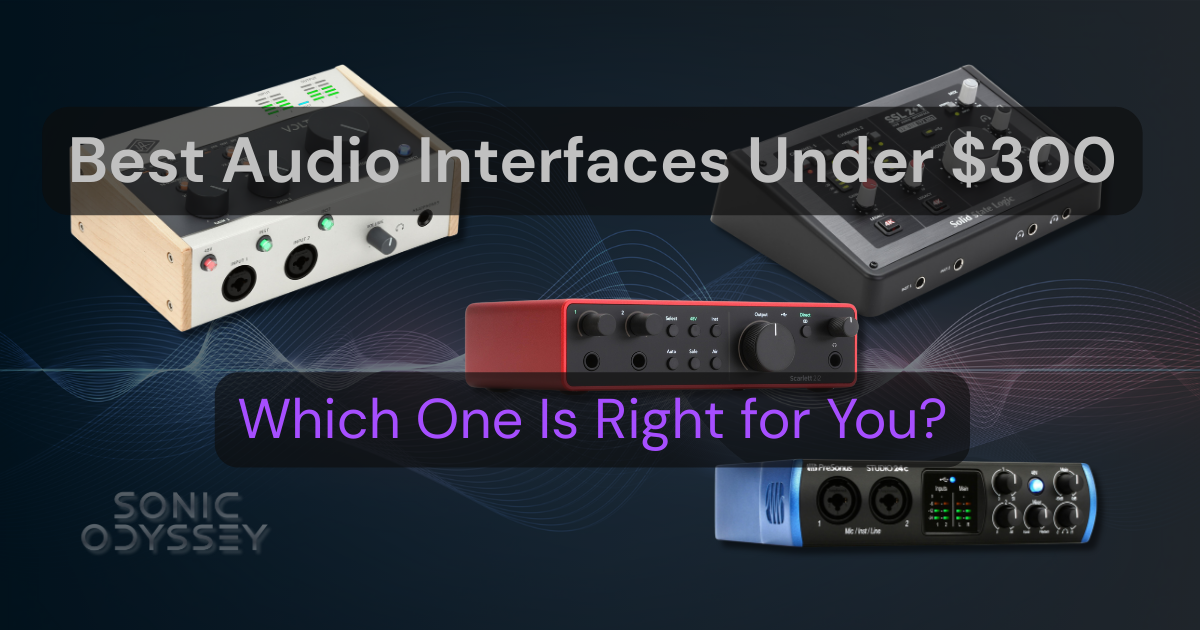
Affordable doesn’t mean amateur — these interfaces punch way above their price.
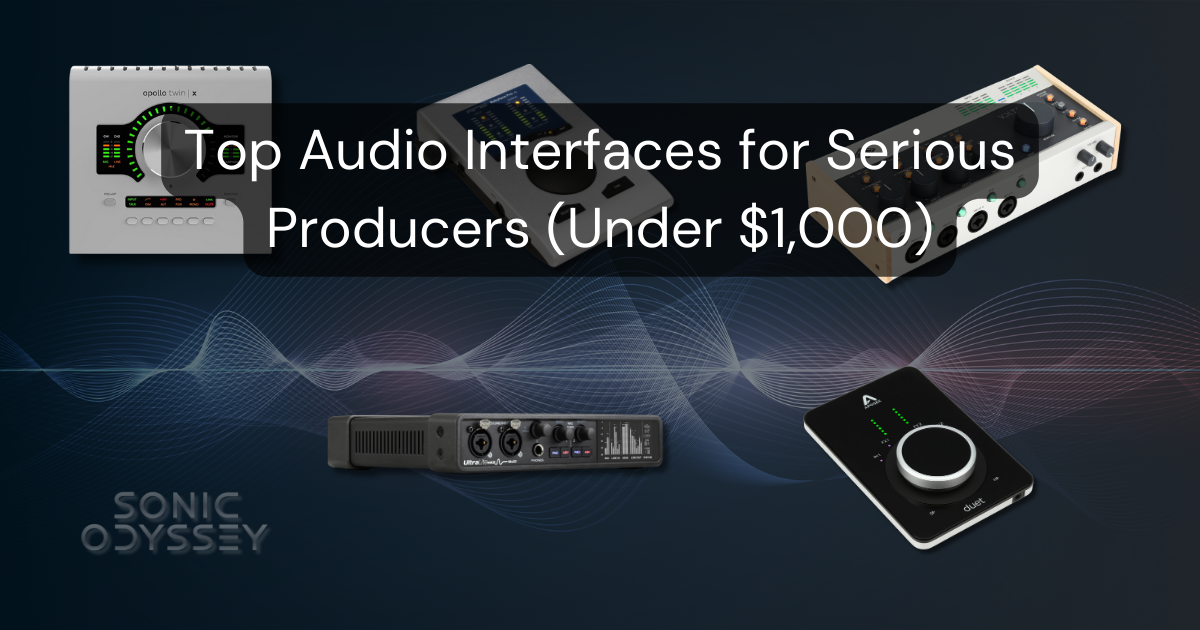
Ready to level up? These interfaces strike the perfect balance between pro features and studio-friendly pricing.
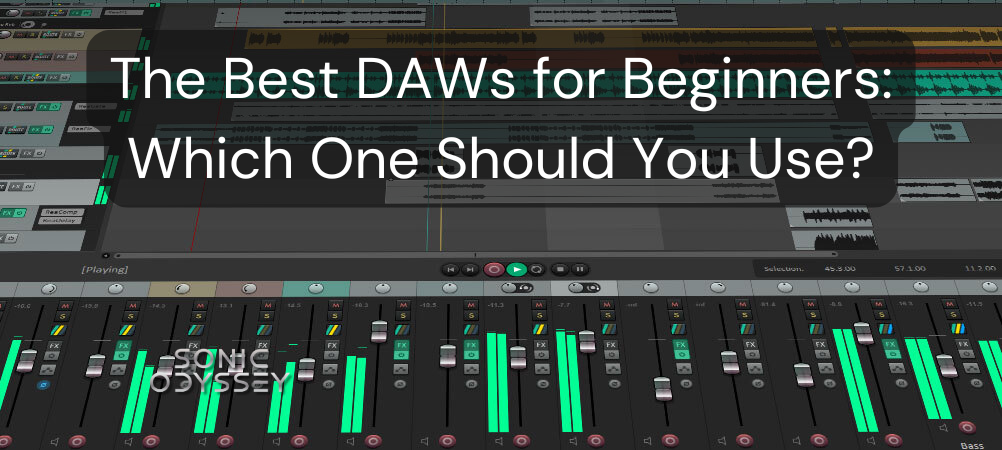
Your first DAW doesn’t have to be overwhelming — this will help you pick confidently.
Introduction: Why Your Interface Choice Matters
Before the DAW era, studios were built around a simple but powerful signal chain: a mixing console, some outboard gear, and a tape machine. You’d plug your mics into the console, dial in your preamp gain, shape the tone with EQ, maybe patch in a compressor or reverb unit, and then route it all to tape. That tape could be a 2” 24-track reel-to-reel if you were in a big studio, or something like a ½” 8-track or even a ¼” 4-track deck if you were working at home. And once it was printed to tape, that was it — no unlimited undos, no virtual instruments, no latency settings.
At home, a lot of us cut our teeth on 4-track cassette machines — Tascam Portastudios, Fostex X-series decks — where the hiss was part of the vibe and you had to bounce tracks if you wanted to squeeze in more layers. It was limiting, but in a way that forced decisions and creativity.
Fast forward to now: that entire analog chain has been virtualized. Your interface replaces the console's mic pres, input routing, and signal conversion. Your DAW takes over the role of the multitrack tape machine — plus editing, mixing, automation, recall, and more. And your computer acts as the central brain, handling everything from audio processing to plugin hosting.
Some folks will tell you “it’s all just 0s and 1s” — and sure, at the binary level, that’s true. But the quality of your front end still matters. Bad preamps, noisy converters, or unstable drivers can absolutely drag down the whole experience. It’s not just about getting sound in and out of the computer — it’s about doing it cleanly, reliably, and in a way that fits how you actually work.
When you buy an interface, you’re not just grabbing a box with inputs — you’re choosing the front end of your entire recording system. And depending on your needs, that could mean anything from a bus-powered two-input portable rig to a rackmount monster with ADAT expandability and onboard DSP.
This is where a lot of beginners get tripped up. Some people overspend on features they’ll never use — eight mic inputs, dual ADAT, onboard DSP — without having a real plan for how they’ll use any of it. Others cheap out and buy something with a single input, only to realize they can’t track vocals and guitar at the same time. There’s also a tendency to focus too much on sample rates and shiny marketing terms instead of what will actually improve their workflow.
When you buy an interface, you’re not just picking a box with some inputs — you’re choosing the front end of your entire recording system. The right one should feel like an extension of how you work, not something you’re constantly fighting against. In the sections ahead, we’ll distill the oceans of information out there into something clear, practical, and focused — so you can make a decision that fits your setup, not someone else’s idea of what’s “pro.”
Start with Your Use Case
Before you even glance at specs, you need to get brutally honest about how you actually plan to use your interface. That’s where most people mess up — they buy for the setup they wish they had, not the one they’re actually working with.
Here’s a breakdown of common use cases, what to look for, and one interface that nails it.
🎙️ Singer-Songwriter
You’re recording vocals, acoustic guitar, maybe the occasional keyboard or percussion track — usually one or two sources at a time.
What you need:
- 2 solid mic/line combo inputs
- Clean, quiet preamps
- Direct monitoring or low-latency operation
- USB-powered for simplicity
Recommended: Focusrite Scarlett 2i2 4th Gen
🎛️ Electronic Producer / MIDI-Centric Setup
Your world is MIDI controllers, synths, drum machines, and virtual instruments. Mic recording is minimal, if at all.
What you need:
- Solid driver stability and low latency
- At least 1–2 inputs for occasional tracking
- MIDI I/O (if you're using hardware)
- Balanced outputs for monitors
Recommended: MOTU M4
🥁 Full Band / Multi-Input Recording
Tracking drums or live band sessions? You’re going to need serious I/O.
What you need:
- 4+ mic preamps (ideally 8)
- ADAT or S/PDIF for future expansion
- Separate monitor and headphone mixes
- Rackmount or desktop — depending on your setup
Recommended: PreSonus Studio 1824c
If you plan to grow your setup over time, make sure your interface has an ADAT input. That lets you add an external preamp like the Focusrite OctoPre down the line — expanding your inputs without buying a whole new interface. The OctoPre Dynamic even includes compression on every channel, which is clutch when you're tracking drums or a full band and want a little safety net on the way in.
💡 What’s ADAT and Why Should You Care?
ADAT is a digital audio protocol that lets you add more inputs to your interface using a single optical cable. If your interface has 8 onboard inputs and an ADAT input, you can add something like the Focusrite OctoPre to get 8 more mic pres without buying a whole new interface. Great for drum tracking or full band setups.
🎙️ Podcaster / Content Creator
You’re primarily recording voice and need consistent, broadcast-quality sound — maybe solo, maybe with guests.
What you need:
- Clean gain with noise-free operation
- Headphone outputs and mix-minus routing
- Built-in loopback for calls or livestreams
- FX or preset options for voice polish
- USB multitrack support (bonus)
Recommended: Rode Rodecaster Duo
A powerhouse all-in-one interface built specifically for podcasting and streaming. Clean preamps, onboard FX, Bluetooth input, USB multitrack, and smart routing — no DAW required to get going fast.
🎒 Mobile / Travel Setup
You need something small, reliable, and USB-powered — whether you’re tracking demos on the road or just want a backup rig.
What you need:
- Compact form factor
- USB bus-powered
- 2 inputs max
- Class-compliant for plug-and-play compatibility
Recommended: Audient EVO 4
🎧 Still not sure which interface is right for you?
Check out our curated gear guides
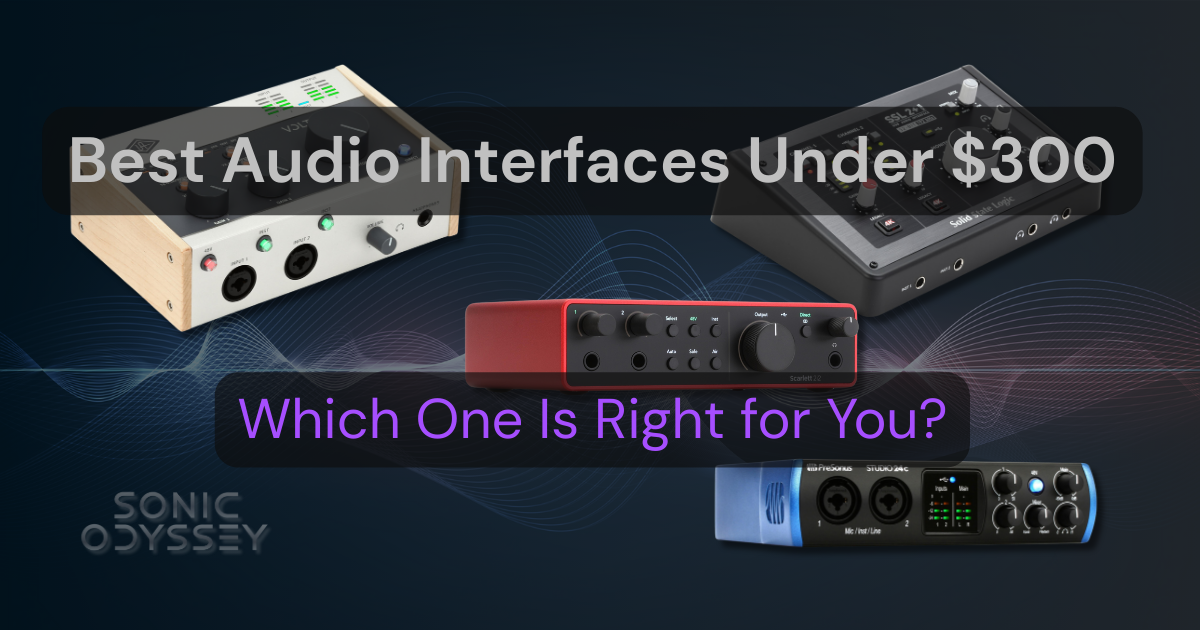
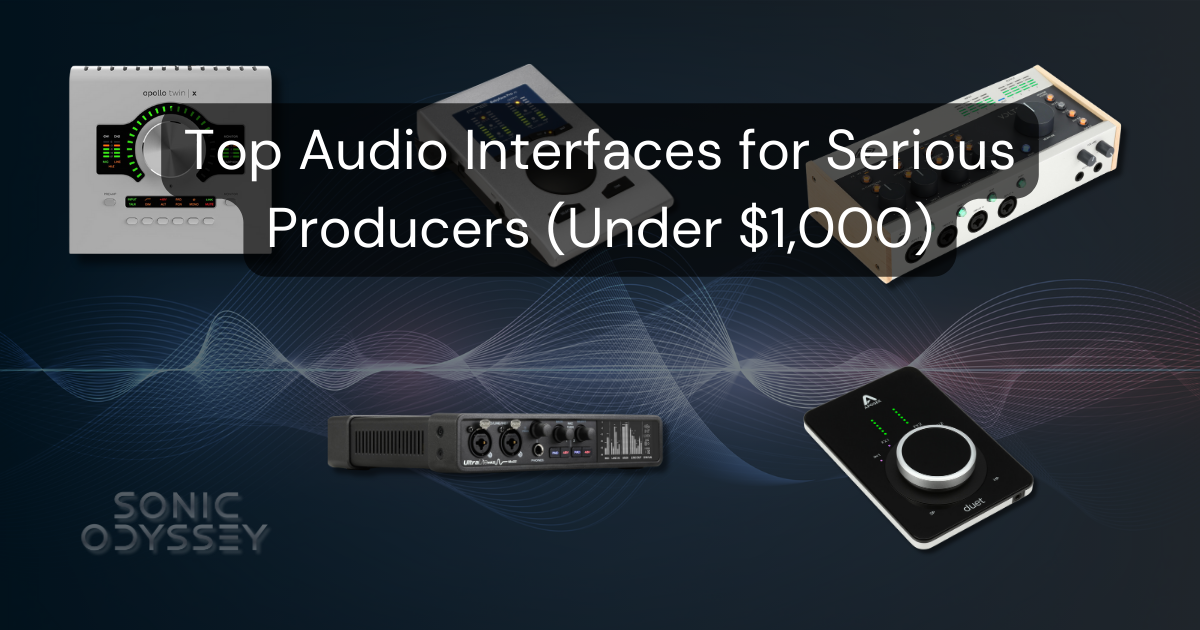
Key Specs You Should Care About
Audio interfaces are packed with numbers — sample rates, dynamic range, total I/O counts that look like they belong on a NASA checklist. And while some of those numbers do matter, a lot of what you’ll find in spec sheets is there to impress, not inform.
This section strips it all down to what actually affects how you record, monitor, and mix — whether you're building your first bedroom rig or expanding a serious setup. No marketing gloss, no gatekeeping — just the stuff you’ll wish you knew before hitting “buy.”
🔌 Inputs and Outputs
Your interface is your front line — if you can’t plug into it, you’re stuck.
- Combo Inputs (XLR/TRS): These are the standard. Plug in mics, instruments, or line-level sources. Most smaller interfaces have 2–4 on the front or back.
- Line Outputs: Usually used for monitors or external gear. More outputs = more routing options.
- Balanced vs Unbalanced: Balanced (TRS or XLR) cables reject noise better — especially on long runs. Stick with balanced cables unless you’re working with consumer gear or plugging a guitar or bass directly into the interface, which typically uses unbalanced TS cables.
🎛️ Quick Note on DB-25 Connectors
Some high-end interfaces — like the Apollo x8p — use DB-25 connectors for their line-level I/O. These look like old printer ports and require breakout cables or patch bays to use. They’re not better or worse — just designed for studios with racks of gear.
🔉 Preamps
This is one of the most important — and most overlooked — parts of your interface. Budget interfaces often cut corners here, and you’ll hear it, especially with low-output dynamic mics or when pushing things like guitar cabs or snares.
- Clean vs Colored:
Most modern interfaces aim for clean, transparent preamps. That’s fine for general use, but some engineers want character — saturation, harmonic richness, or even a subtle EQ curve baked in.Here are a few options that bring real analog personality — with very different price tags:- SSL 2 / SSL 2+ — Include a “Legacy 4K” switch that emulates the subtle EQ curve and high-frequency lift of a classic SSL 4000-series console. It’s not a gimmick — it adds some serious vibe to vocals, bass DI, or anything that feels a little too clean.
- Universal Audio Apollo series — Not budget-friendly in any universe, but the Unison preamps are genuinely impressive. They emulate analog gear at the circuit level — input impedance, gain behavior, harmonic response — and yes, the click of the relays when you load one is deeply satisfying. Like a little gear goblin whispering, “It is done.”
- Universal Audio Volt series — A far more affordable option from UAD. You don’t get Unison, but you do get “vintage mode” preamps that add some tasteful warmth without overcooking your signal.
And if you're stepping beyond interfaces into rackmount preamps:
- SSL PureDrive units are shockingly affordable for how good they sound. I run a pair of SM57s and a pair of 545SDs through mine for Fredman-style guitar cab mic'ing. You get that crisp SSL clarity when you want it, or you can dial in Drive for a thicker, more aggressive tone without fuzzing up your transients.
Or, you know — you can absolutely destroy waveforms and clip the shit out of everything. I’m not here to tell you what to do. Don’t @ me. - Gain Range Matters:
Some mics (especially dynamics like the SM7B or RE20) need 55–60dB of clean gain. If your interface tops out at 45dB, you’re going to need a Cloudlifter or a FetHead — or you're going to be riding the noise floor hard. - Phantom Power (+48V):
Required for condenser mics. This is standard now, but double-check anyway — especially on older or portable interfaces. - Pad Switches:
Useful when you’re miking loud sources (guitar amps, snare drums, horns, etc.) and don’t want to clip the input.
🎧 Conversion Quality
Every interface converts analog signals (like vocals, guitars, synths) into digital ones your computer can understand — and vice versa when you’re listening back.
- Bit Depth & Sample Rate: You’ll see specs like 24-bit / 48kHz, 96kHz, or even 192kHz. In reality:
- 24-bit / 48kHz is more than enough for almost any project.
- 96kHz has niche use cases (pitch/time manipulation, analog modeling). More samples = better resolution for plugin math and audio warping.
- Useful for vocal tuning, sample stretching, amp sims, or saturators that alias at lower rates.
- 192kHz is mostly marketing unless you’re recording bat sonar.
- AD/DA Converters: This is the circuitry doing the actual audio-to-digital and digital-to-audio translation. On paper, most converters today look great. In practice, higher-end interfaces (like RME, Apollo, MOTU AVB, Prism, etc.) tend to have tighter stereo imaging, lower noise floors, and a more refined sound.
- Will a beginner hear it? Probably not.
- Will someone with seasoned ears hear the difference? Absolutely.
🔌 Connectivity
Not all USB is created equal — and there’s more to watch for than just the shape of the plug.
- USB, USB-C, Thunderbolt:
- USB 2.0 still shows up in budget interfaces, but it’s increasingly outdated. Limited bandwidth, no power negotiation, and potential for bottlenecks if you're pushing multiple inputs or running on a modern OS.
- Modern USB (3.x and up) is a whole different beast — dramatically faster, more stable, and capable of handling large multichannel sessions with low latency. It’s the default for most current-gen interfaces.
- USB-C is just the connector — it doesn’t tell you anything about speed. The protocol underneath could be USB 2.0, USB 3.2, USB4, or Thunderbolt 3/4 depending on the device.
USB 3.x and up is ridiculously fast — more than enough for full multichannel audio interfaces. USB4 and Thunderbolt are basically interchangeable at this point for most users.
And no, FireWire is not better. It had its moment in 2007. Let it rest.
- ADAT & S/PDIF:
- Used to add extra channels via external gear. Great for expanding without replacing your interface.
- Only matters if you're planning to scale up your I/O (like adding a preamp for drums or routing in digital gear).
- Class-Compliant vs Driver-Based:
- Class-compliant interfaces work out of the box (especially on Mac or iOS), but may lack advanced routing or software features.
- Interfaces with dedicated drivers often offer better latency performance and more robust control panels — especially important on Windows.
Make sure your computer actually supports the connection type. This is less of an issue on Macs, but on Windows machines, USB 3 or Thunderbolt compatibility isn’t always obvious.
Check the manufacturer’s driver release history, read user reviews, and hit up Reddit subs like r/audioengineering to see how these interfaces behave in the real world."
Software Bundles: Hidden Value or Just Filler?
A lot of interfaces — especially in the entry-level to mid-tier range — come with bundled software. You’ll see logos for DAWs, plugins, virtual instruments, and “artist editions” of tools plastered all over the box. But is any of it actually useful?
The short answer: sometimes, yes.
🎁 What You’ll Typically Get
Most software bundles include some mix of the following:
- A lite version of a DAW (Ableton Live Lite, Cubase LE, Studio One Artist, etc.)
- A small selection of effects plugins (EQs, compressors, reverbs)
- One or two virtual instruments (synths, drum kits, samplers)
- Utility tools like tuners, metering plugins, or amp sims
Some brands bundle plugins from third parties, while others stick to their own ecosystem. It’s worth checking exactly what you’re getting before assuming it’s a full production suite.
UAD Apollo interfaces, for example, often require you to purchase them with a specific plugin package tier, which raises the price even if you only care about the hardware.
It’s not always a bad deal — but it’s not exactly optional, either.
🧠 What’s Actually Useful
- Ableton Live Lite is limited, but still powerful — a great entry point for electronic and loop-based producers.
- PreSonus Studio One Artist is generous and well-integrated if you're using a PreSonus interface.
- Focusrite and SSL bundles often include plugins from Softube, XLN Audio, or Antares, which are actually great starting points.
- UAD Volt interfaces include bundled 1176 compressor plugins, which are legitimately useful and not just fluff.
I bought my first Pro Tools rig back in 2008 — an Mbox 2. Rough. But here’s the thing: a lot of the plugins and software I still use today came from that absurdly bloated bundle.
Some companies offer crossgrades and upgrade discounts based on old bundled licenses, so don’t sleep on them.
If you’re a sneaky little (or large) goblin like me, you can slowly collect legit, pro-level tools without sacrificing either kidney.
Play your cards right, and one day you too might be able to upgrade to Waves Mercury for $5 and a scratched-up copy of Halo.
🙃 What’s Less Useful
- “Lite” versions of plugins with no upgrade path
- Demos disguised as bundled software
- DAW versions with major restrictions (e.g. no third-party plugins, export limits)
- Anything that requires five signups and a scavenger hunt to download
I’ve been a Pro Tools user for nearly 20 years, but I know that’s not everybody’s jam. Don’t depend on some bundled software. Get Reaper and don’t look back. It’s cheap, lightweight, and infinitely customizable.
The workflow drives me nuts, but that’s just because I’m old and stuck in my ways and WHY DON’T THEY PLAY MUSIC I LIKE ON THE RADIO ANYMORE.
(Okay, sorry. I went a little Rick Beato there. I’m not a Boomer. I was born in the ’70s, for fuck’s sake. Sorry about that. Don’t @ me.)
Budget Considerations
Choosing the right interface means balancing your needs with your budget — and being honest about how much room you want to leave for growth. Some people grab the cheapest thing to get started and upgrade later. Others would rather invest once and not think about it again for five years. Both approaches are valid — what matters is knowing what you're really paying for.
Here's a general breakdown of what you can expect in each price tier, and what kind of user each one suits best:
🎧 Under $200
- Great for solo artists, home studio beginners, and streamers
- Typically 2-in/2-out USB interfaces with basic I/O and clean, no-frills preamps
- Very portable, often bus-powered
- Examples: Focusrite Scarlett Solo, MOTU M2
- Many come with bundled software — but see the Software Bundles for a reality check
🎛️ $200–$500
- This is the solid home studio tier
- More inputs and outputs, better gain structure, cleaner converters
- You’ll start seeing:
- Dual headphone outs
- MIDI I/O
- Loopback functionality
- Some light DSP or onboard FX
- Great for hybrid setups, small studios, or users who want room to grow
- Examples: Audient iD14, Universal Audio Volt 476, MOTU M4, Focusrite Scarlett 4i4
🧠 $500–$1000
- Now you’re in professional project studio territory
- Expect:
- Excellent conversion and clocking
- Expanded routing and I/O
- ADAT/S/PDIF expandability
- DSP-powered effects (e.g., UAD)
- Better headphone amps and monitor control
- Interfaces in this range often act as the brain of your whole studio setup
- Examples: Universal Audio Apollo Twin, RME Babyface Pro FS, Apogee Duet 3
🏢 $1000 and Up
- This spans the range of high-end prosumer to fully professional studio hardware
- Designed for commercial studios, high-end production suites, and serious home setups that demand the best
- Expect:
- Multi-channel AD/DA conversion
- Dedicated monitor control and metering
- Tight clocking and word clock I/O
- Thunderbolt connectivity and DSP-heavy plugin ecosystems
- Rackmount form factors and DB-25 / AES options
- Examples: Universal Audio Apollo x8, RME Fireface UFX III, Antelope Orion Studio, Apogee Symphony Desktop
Spend more if you need specific features — not just because a YouTuber told you to.
Brand Considerations and Driver Support
Let’s talk brands. Not in a “15 interfaces ranked by vibes alone” kind of way — just real-world perspective on who makes what, how well it works, and how likely it is to ruin your weekend with a driver update from hell.
Here’s a breakdown of the most common audio interface brands you’ll come across, listed alphabetically, along with what they do well (and not so well).
🟣 Apogee
- Strengths: Excellent AD/DA conversion, sleek designs
- Known for: Duet, Symphony Desktop, Boom
- Driver Stability: Very good on macOS; limited Windows support
- Extras: Tends to pair best with Logic Pro
- Real talk: Mac-first and proud of it. Gorgeous sound, but not always worth the premium unless you're staying in the Apple lane.
🟠 Antelope Audio
- Strengths: High-end sound, FPGA-based FX, clocking tech
- Known for: Zen Go, Orion, Discrete 4/8
- Driver Stability: Historically shaky, but improving
- Extras: Huge plugin library (some free, most not)
- Real talk: Sounds great when it works. Just make sure it works on your system before you commit.
🔵 Audient
- Strengths: Transparent preamps, good build quality
- Known for: EVO series, iD4/iD14/iD44
- Driver Stability: Good across platforms
- Extras: Loopback is nice; EVO software is getting better
- Real talk: Solid choice if you want clean sound and don’t need flashy DSP.
🔵 Behringer
- Strengths: Inexpensive, widely available, gets the job done
- Known for: UMC22/UM2, UMC404HD
- Driver Stability: Surprisingly decent, class-compliant models are plug-and-play
- Extras: None to speak of
- Real talk: They're cheap and they work. That’s the whole pitch.
🔴 Focusrite
- Strengths: Affordable, reliable, widely supported
- Known for: Scarlett series, Clarett+ line
- Driver Stability: Solid, especially on Mac. Windows can occasionally lag behind.
- Extras: Good plugin bundles, easy setup
- Real talk: The Scarletts are the Toyota Corollas of interfaces. Not flashy, but they just work.
⚫ MOTU
- Strengths: Excellent conversion, great build quality, very stable drivers
- Known for: M2/M4 (budget beasts), UltraLite series, AVB interfaces
- Driver Stability: Among the best, particularly on Windows
- Extras: Great software mixer
- Real talk: If you want low latency without jumping into the RME tax bracket, MOTU is the move.
🟣 PreSonus
- Strengths: Tight integration with Studio One, decent preamps
- Known for: Studio series, AudioBox line
- Driver Stability: Varies by product line and OS
- Extras: Bundled software is a win if you’re a Studio One user
- Real talk: Better than people give them credit for, but watch for corner-cutting on their lowest-end models.
🟡 RME
- Strengths: Rock-solid drivers, total routing control, elite-level stability
- Known for: Babyface, Fireface, Digiface, PCIe interfaces
- Driver Stability: Arguably the best in the industry
- Extras: TotalMix is a powerhouse (and a rabbit hole)
- Real talk: If you’re done messing around and want zero drama, RME is the endgame.
⚫ Steinberg
- Strengths: Decent preamps, tight Cubase integration
- Known for: UR series, AXR4
- Driver Stability: Usually reliable, with good Mac support
- Extras: Often bundled with Cubase AI/LE
- Real talk: Worth it if you’re in the Steinberg ecosystem. Otherwise, better options for the money.
⚪ Universal Audio (UAD)
- Strengths: Excellent DSP-based plugins, clean conversion, Unison preamps
- Known for: Apollo Twin/X/8, Volt series
- Driver Stability: Great, but tied to UAD ecosystem
- Extras: Requires account, app, plugin manager, and sometimes ritual sacrifice
- Real talk: Fantastic gear, but you're buying into a walled garden. Know what you’re signing up for.
🛠 Driver Stability, Firmware, and Class Compliance
Not all interfaces are created equal when it comes to driver support. Some brands are rock solid across OS updates and chipsets. Others... leave you reading Reddit threads at 2AM wondering if you made a terrible mistake.
- Class-compliant interfaces (like many Behringer or MOTU models) work out of the box with Mac, iOS, and some Linux systems — no drivers needed. That’s great for plug-and-play simplicity, especially on mobile setups.
- Driver-based interfaces (like UAD, Focusrite, and RME) often require dedicated software and firmware updates to stay compatible with new OS releases. When done well, this gives you better performance and deeper control. When done poorly, it can brick your setup.
If you're using Windows, prioritize brands with strong driver reputations — RME, MOTU, and Audient consistently deliver stable performance, even under heavy load. Windows has historically been more finicky with audio drivers due to how it handles real-time audio processing, so good drivers are non-negotiable. On Mac, you're generally safer across the board thanks to Core Audio, but class-compliance still adds peace of mind.
Final Thoughts: Buy Smart, Not Expensive
There’s no such thing as the perfect interface — only the one that fits your workflow, your gear, and your very real budget. Don’t get caught up chasing specs you’ll never use or boutique hype that doesn’t survive contact with your actual mix session.
Whether you’re grabbing your first $129 box or upgrading to a rackmount beast, the same rule applies: know what you need, understand what you’re buying, and build the rest of your signal chain accordingly.
And if someone tries to tell you it’s “just 1s and 0s,” smile politely… and then hit them with a DI’ed riff, a reamped vocal chain, and a room that actually sounds like music was meant to be made in it.
Don’t @ me.
🎯 Ready to Buy?
Check out our related gear guides:
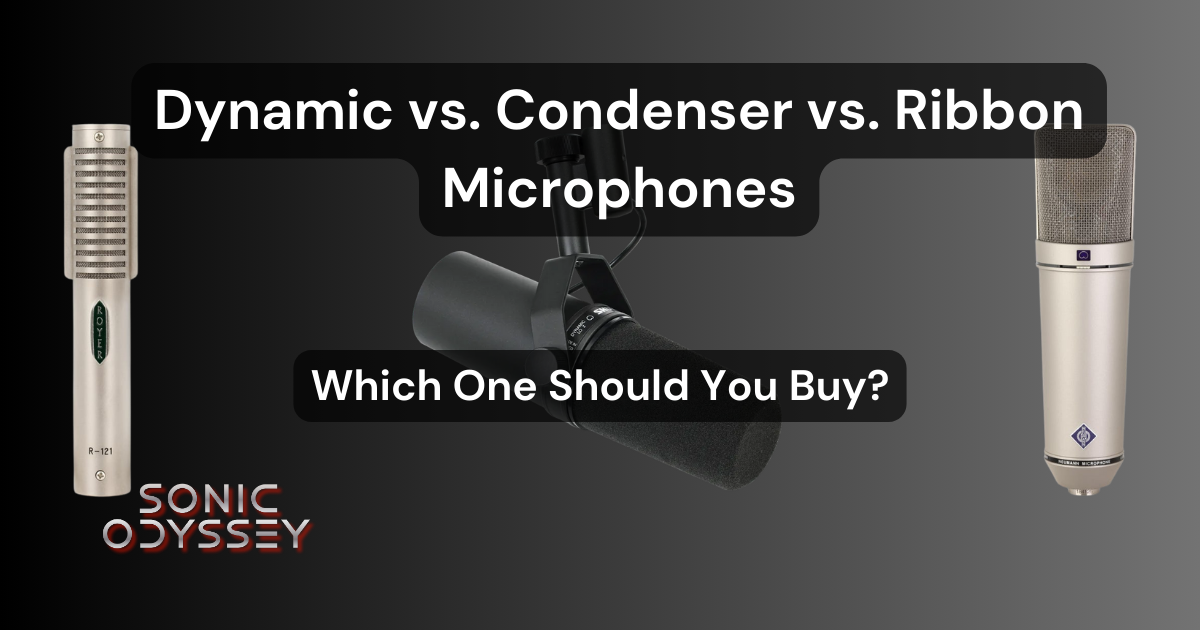
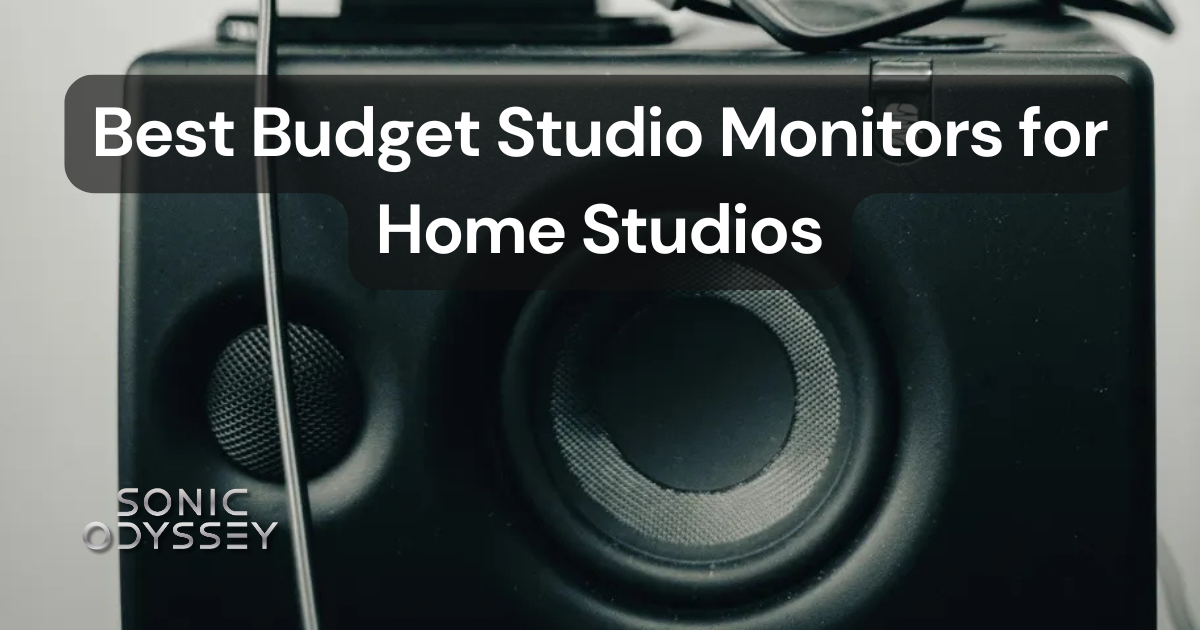
Or browse our full Audio Interface Roundups for more recommendations by budget, workflow, and I/O needs.
This article contains affiliate links. If you purchase through one of these links, we may earn a small commission at no additional cost to you. It helps us keep the lights on (and the gear obsession alive).












